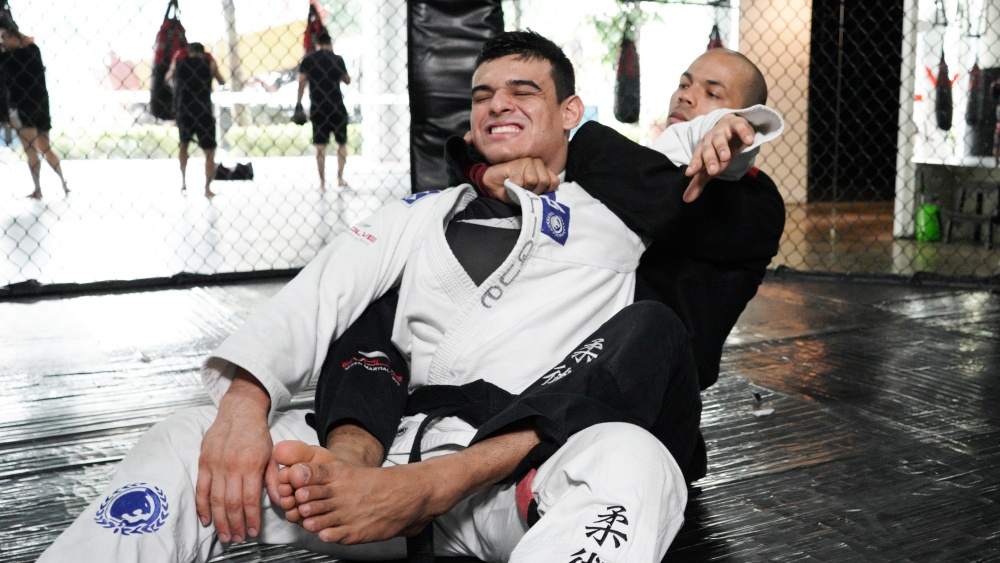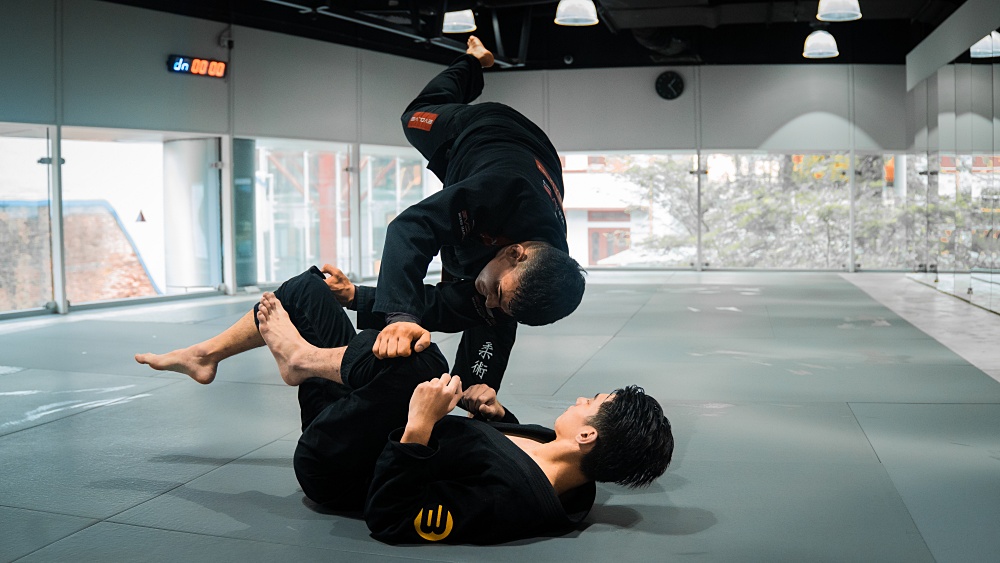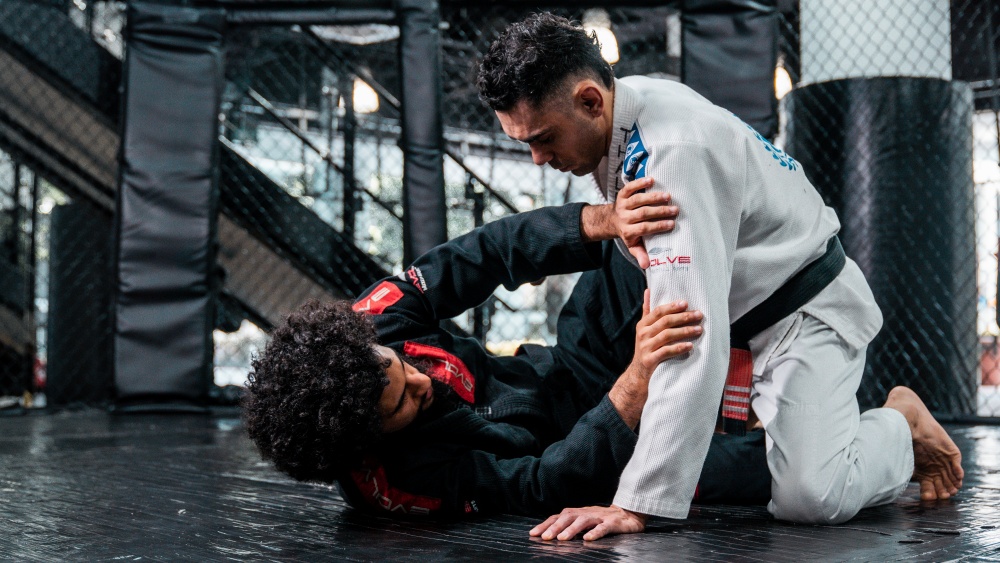Brazilian Jiu-Jitsu (BJJ) is a grappling-based martial art and a form of self-defense originating from Brazil. It was created by the Gracie brothers after they modified techniques and philosophy from Japanese Jujutsu. Brazilian Jiu-Jitsu focuses on ground fighting and submission techniques, but it’s so much more than that. BJJ is like a chess game played on the ground, where practitioners use leverage, technique, and strategy to overcome opponents, regardless of size or strength.
Due to the martial art’s nature of not using brute force, and therefore more welcoming for beginners, BJJ is one of the fastest-growing martial arts today. It has grown steadily over the past few decades and has now become more accessible than ever. The sport is one of the best workouts you can do as it offers a variety of benefits, such as weight loss, improved confidence, problem-solving skills, and discipline. It also enhances your ability to deal with pressure, as it is an excellent tool for self-defense. Today, let’s discuss what BJJ is.
What Is BJJ?
While it mainly focuses on grappling (clinch and ground fighting), it is considered a comprehensive self-defense system that includes throws, stand-up techniques, and strategies against weapon and surprise attacks.
One of the most fascinating aspects of BJJ is its emphasis on leverage and technique over brute force. You don’t have to be the biggest or strongest person in the room to excel in BJJ. Instead, it’s all about using your body as efficiently and effectively as possible.
Like most martial arts, BJJ is also practiced as a competitive sport. The rule set varies from tournament to tournament, but usually, striking techniques are not allowed in the sport context. Jiu-Jitsu can be practiced by wearing a uniform called the gi. Alternatively, you can also train without it (no-gi). Remember that a legitimate BJJ black belt instructor should be well-versed in every aspect of the art, be it in gi, no-gi, sport, or self-defense.
As mentioned earlier, it is a comprehensive self-defense system that allows smaller, weaker individuals to defend themselves against bigger, stronger, and more athletic opponents using proper technique, leverage, and, most of all, by taking the fight to the ground. By closing the distance and using gravity to your advantage, practitioners can effectively neutralize opponents of all shapes and sizes. The strategy consists of taking away the opponent’s strengths and ability to win as you apply your own.
The longer you stand and trade punches with an opponent who is bigger and stronger, the higher their chances of hitting you with a damaging strike. The bigger and stronger the opponent, the harder they can hit, the more damage they can take, and the longer their reach is, giving them the advantage to hit you without getting hit. Longer reach and powerful strikes are both mitigated when grappling on the ground.
Jiu-Jitsu is a methodical self-defense and fighting system. Its application can be broken down into four phases: the first phase is closing the distance and clinching with the opponent. The second is to take the fight to the ground. Third is achieving a dominant position by the use of pins. Lastly, the fourth phase is finishing the fight.
Phase 1: Closing The Distance
Learning how to safely close the distance against someone trying to hit you is one of the most important aspects of BJJ. The goal is to create or find an opening depending on the type of opponent you are facing.
Half of the work is already done if you are against someone aggressive and constantly moving forward with the intent of hitting you. This is because the opponent is helping you to close the distance. The key here is to time the entry safely and cover your face to avoid any unexpected blow.
When facing someone who is defensive and is trying to pick their shots, you have to initiate by throwing strikes to distract them as you close the distance. Closing the distance is one of the main differences between Jiu-Jitsu for self-defense and sport. In sport BJJ, strikes are not allowed when closing the distance, and you are facing an opponent who is willing to grapple with you.
Phase 2: Taking The Fight To The Ground
Taking the fight to the ground is a vital part of the system as it helps you mitigate the opponent’s reach advantage and powerful strikes. There are different ways to take the opponent down after establishing the clinch, such as leg trips, throws, and upper and lower body takedowns. Taking the fight to the ground and keeping the top position is the main goal in an actual fight situation since most of the opponent’s strikes from the bottom position are ineffective.
Although not advisable, some BJJ practitioners might choose the bottom position when taking the fight to the ground. This is a technique known as “pulling guard”. BJJ practitioners do this when they have a hard time executing a takedown.
Knowing your opponent’s instinctive behaviors and adjusting to them will make you effective from the bottom position. Pulling guard is common in sport Jiu-Jitsu; the bottom position is without a doubt one of the most sophisticated parts of the game. A BJJ practitioner must be equally skilled in top and bottom positions to ensure that all bases are covered.
Phase 3: Achieving A Dominant Position
After taking the fight to the ground, the next step is achieving a dominant position. This will give you great control over your opponent by adequately using your body’s weight distribution, leverage, and gravity to pin them down. A dominant position will not only allow you to set up your attacks but also limit your opponent’s escapes and potential of doing damage. There are four central positions in BJJ: the guard, side control, full mount, and back mount.
Most of the time, you will find yourself in those positions. It follows a hierarchy, with some positions being more advantageous than others. The guard gives you the ability to use your legs to manage the distance, control, and attack the opponent while fighting off your back. This is what separates BJJ from other grappling-based martial arts, as no martial art in the world has a guard as developed as the one in Jiu-Jitsu. A good guard will not only allow you to defend against strikes but also make way for sweeps and reversals.
There are different types of guards you can use depending on how you manage the distance between you and the opponent. The three main guards are closed, half, and open guard. Each of these guards can be subdivided into many more. Just keep in mind that the primary option in a real fight situation is to keep the top position.
But if you end up in the bottom position, playing the guard is your best choice. The guard is a dangerous position that offers different entries for attacks and reversals; just be wary of the potential strikes that might come as you transition to your offensive techniques.
Side control is the first dominant position you should look for when you get to the top position. Initially, you aim to pass the opponent’s guard by getting around their legs. It is followed by going for a pin by placing your body in a perpendicular position in relation to theirs. This makes it difficult for them to recover their guard.
From there, you have many options for offense, especially in sport Jiu-Jitsu, where you can use the Gi as a tool to attack. In an actual fight situation, side control is mainly used to hold the opponent down as you look to improve your positioning by transitioning to the mount or back mount. There are also different ways to control the opponent while in side control, such as the chest-to-chest, kesa gatame, reverse kesa gatame, and north-south position.
The mount is the second most dominant position in the Jiu-Jitsu hierarchy. It offers fantastic control over the opponent and a set of high percentage attacks. The main reason the mount is such a dominant position is that you can inflict significant damage with punches and elbows, with little to no risk of being attacked because of the reach advantage you will have from the mount.
Due to the mount’s potential to end a fight in an instant, a common reaction of the opponent is to turn their back to protect their face, making things worse for them. In sport Jiu-Jitsu, chokes are the equivalent of punches. You can definitely punch the opponent if you can’t choke them from the mount.
The back mount is the most dominant position in BJJ. This is because you have excellent control over the opponent while they can’t see where your attacks are coming from. It is easier to choke the opponent out the more they try to punch you since they’re not defending their neck.
Getting the back mount is the end of the line positioning-wise. You only go back to side control or mount if you lose control of the back mount. The most ideal approach is maintaining back control until you finish the opponent.
Phase 4: Finishing The Fight

Submissions become your allies towards the end of a fight, especially when you’ve secured control from a dominant position.
After achieving a dominant position and establishing control of the opponent, the next step is to finish the fight using submission holds or strikes. Submissions can be categorized into two groups: chokes and joint locks. Let’s talk about chokes first.
Chokes can be further classified as air and blood chokes. Air chokes are executed by compressing the trachea, which leads to asphyxia. The compression can be applied using both your legs or arms. Blood chokes are executed by compressing the carotid arteries, cutting or limiting the blood supply to the brain, which can cause unconsciousness and even death if the choke is held for a prolonged period.
Joint lock submissions can be applied to any joint of the human body by forcing the joint to move past its normal range of motion. Some of the most popular submissions in BJJ, starting from the wrist joint, is the wrist lock. Wrist locks are applied by hyperextending, hyper flexing, or rotating the joint. Wrist locks can be hit from almost any position and are one of the sneakiest submissions in BJJ.
Moving up to the elbow joint, the most common attack is the armbar, causing the hyperextension of the joint. It is one of the fundamental submissions in BJJ, but it takes a lot of practice to become efficient with it. The armbar is a great example in BJJ of creating a mismatch, as it uses your lower body against the opponent’s upper body. Practice drilling it in closed guard countless times until you get used to pivoting the hips. Understand the mechanics of pulling and pushing motions to become successful with this submission.
Onto the shoulder joint. The kimura, Americana, and omoplata are the primary attacks against the shoulder joint and rotator cuff. The Kimura and Americana are known as big man submissions in BJJ as it favors bigger and heavier grapplers because of their heavier weight distribution and leverage.
These two submissions are applied with a figure-four grip by grabbing the opponent’s wrist as you apply a twisting motion to create pressure towards the shoulder joint. The omoplata is similar in context but uses your legs and hips to attack the opponent’s scapula by extending it. Apart from being a submission, it is also used to control and sweep the opponent.
Let’s move to the neck. Neck cranks can be applied in various ways, attacking the neck at different angles. The most common submissions are the rear naked choke, can opener, and the twister. The rear naked choke is among the strongest submissions in BJJ and by far the most popular choke. The perfect rear naked choke blocks the blood supply to the brain.
As the opponent defends, most rear naked chokes are transformed into neck cranks, which, instead of applying pressure to block the blood flow, now targets the neck and spine. The can opener and twister are two very good examples of cranks. Both are considered dangerous techniques and should only be practiced by beginners with the guidance of a coach.
Moving to the lower body, the banana split and crotch ripper are the most common attacks on the hip joint. At the knee joint, knee bars and heel hooks are the primary attacks. Last, the ankle joint, where toe holds and straight ankle locks are the go-to submissions. Lower body submissions are seldomly taught to beginners as it requires experience and a deep understanding of body mechanics to be safely practiced in sparring with proper control.
Try BJJ Today!
With all that said and done, we must not forget about the sense of community that comes with training in BJJ. Part of what makes BJJ great is the community and connectio nthat you create overtime. Whether you’re a beginner or a seasoned practitioner, you’ll find yourself welcomed into a supportive and inclusive community of fellow grapplers who share your passion for the art.
Jiu-Jitsu is an activity that is recommended for everyone, regardless of their background. It is one of the safest martial arts to train in and is a tried and tested means for improving one’s outlook in life. Now that it is more accessible than ever.
So, if you’re looking for a challenging yet rewarding martial art that will not only sharpen your physical skills but also nourish your mind and spirit, look no further than Brazilian Jiu-Jitsu. Come join us on the mats and embark on a journey of self-discovery and growth unlike any other at Evolve MMA’s complimentary introductory BJJ classes.
Book your complimentary trial class with our World Champions below!
If you have any other questions regarding Evolve MMA and the programs we offer, you can get in touch with our membership executives at the following locations:
Evolve MMA (Far East Square)
26 China Street
Far East Square #01-01
Singapore 049568
Phone: (65) 6536 4525
Evolve MMA (Orchard Central)
181 Orchard Road
#06-01 Orchard Central
Singapore 238896
Phone: (65) 6536 4556
Evolve MMA (KINEX)
11 Tanjong Katong Road
#02-52 KINEX
Singapore 437157
Phone: (65) 6288 2293
Evolve MMA (Clarke Quay Central)
6 Eu Tong Sen Street
#04-18 Clarke Quay Central
Singapore 059817
Phone: (65) 6226 2150
Evolve MMA (Star Vista)
1 Vista Exchange Green
#02-26A The Star Vista
Singapore 138617
Phone: (65) 6539 9590

















